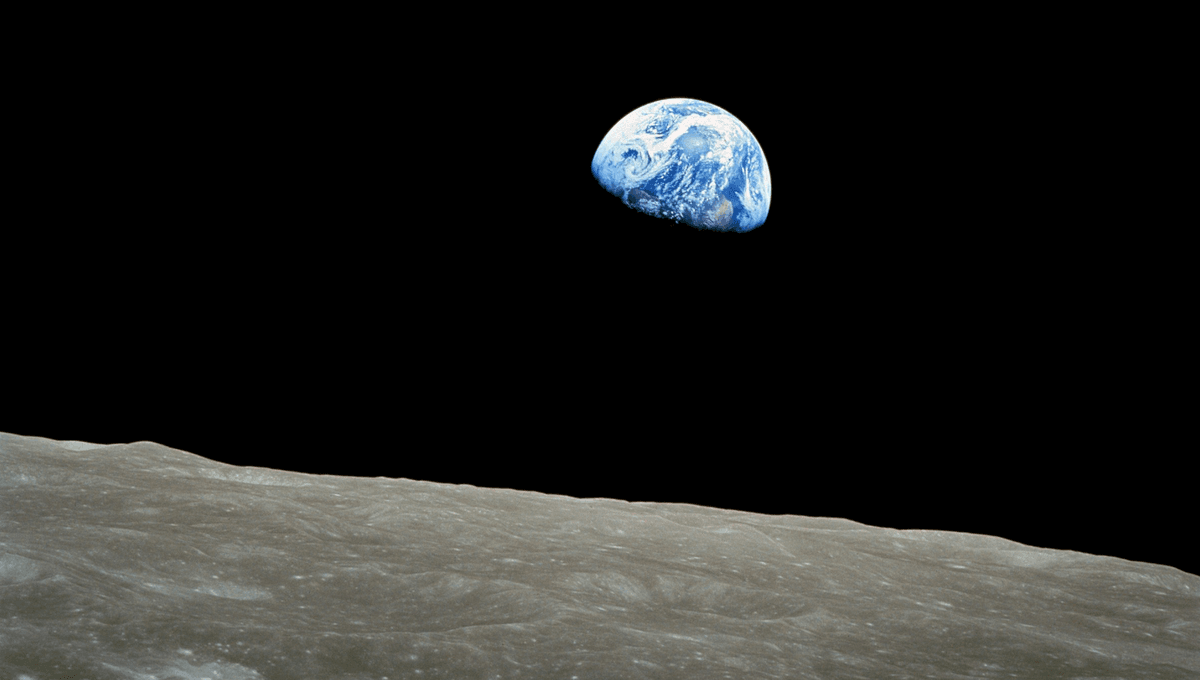
The photograph of the Earth taken from lunar orbit, sometimes known as “Earthrise”, is one of the most famous ever taken. However, while its beauty is widely agreed on, it gives little sense of scale, let alone brightness. So how bright did the Moon look to the Apollo astronauts? Is there anything useful future lunar residents could make of its light?
In previous explainers we have looked at the brightness of the planets from each other, such as how bright the Earth looks from Mars. These are all put in the shade by the way a planet can dominate the sky from the surface of one of its satellites.
The brightness of a planet or moon from somewhere else depends on five factors: distance, the size of the object, its distance from the Sun, how reflective it is (albedo), and how much of it is illuminated by the Sun.
The distance from the Moon to the Earth is unsurprisingly the same as from the Earth to the Moon, and the distance of each to the Sun is so similar that these can be ignored.
The Earth’s radius is 3.7 times that of the Moon, so it has 13.4 times the surface area. The Moon’s albedo is 0.136, while the Earth’s is 0.434, making the Earth 3.2 times as reflective. That figure varies of course, depending on cloud and whether you’re facing mostly ocean or land. On average, however, putting those together, when the Earth is close to full, as seen from the Moon, it’s beaming back 43 times as much light at the Moon as the full Moon does to Earth. Moonlight is brighter for a supermoon than one when the Moon is more distant, and the same would apply in reverse, but in general we are talking 2-10 lux.
Of course, the brightness of the Moon from Earth is affected by clouds or atmospheric distortion. Lunar astronauts won’t need to worry about that, but they won’t have an unimpeded view of the Earth either, unless they’re about to be very dead, because the visor of their spacesuit will block some light. We don’t know how much that will be – space suits will probably improve with time, so let’s just assume these factors cancel out.
That leaves the matter of how full the Earth is. From the nearside of the Moon, the Earth is always in the sky, but it waxes and wanes just as the Moon does for us, depending on which side the Sun is illuminating. Helpfully, however, if you’re somewhere central on the nearside, the Earth is only a crescent in daytime, when its light isn’t needed. During the long lunar night, the Earth’s always at least half full.
So, let us imagine you’re an astronaut far from base and your torch has failed. You come across an object with writing on it (steady on, it doesn’t need to be an alien spacecraft, it could be one of the plaques left behind by the Apollo missions). How easy would it be to read by earthlight?
That would depend on factors such as the clarity and size of the font, but under the right circumstances people sometimes manage to read by the light of a full Moon, and not just large signs.
To read more than a few lines of a book or plaque, however, generally requires a fair bit more light than the Moon provides. Even earthlight would be far less than most of us would prefer to read something that doesn’t come with its own lighting. Hundreds of lux are recommended for comfortable reading. Still, with typical eyesight you could probably read the plaque’s message by earthlight if necessary, even if your eyes might hurt a bit afterwards.
What about charging your solar panels? Here I’m afraid the news is not so good and we need to compare earthlight with sunlight, not moonlight.
Direct sunlight can be more than 100,000 lux, although more often it’s a bit less. A heavily overcast day, the sort where the best solar panels might just be giving a trickle of power, is about 100 lux. You might be able to make solar panels that could run a Christmas tree light on less than 10 lux, just to prove it could be done. Realistically, however, if you want to run a base on solar power through the long lunar night, best to either get some huge batteries, or long transmission lines.
The weakness of earthlight does explain why a lot of scientists were very skeptical of the claims the pandemic affected the lunar temperature.
All “explainer” articles are confirmed by fact checkers to be correct at time of publishing. Text, images, and links may be edited, removed, or added to at a later date to keep information current.
Source Link: How Bright Is The Earth From The Moon And Could You Read By It?